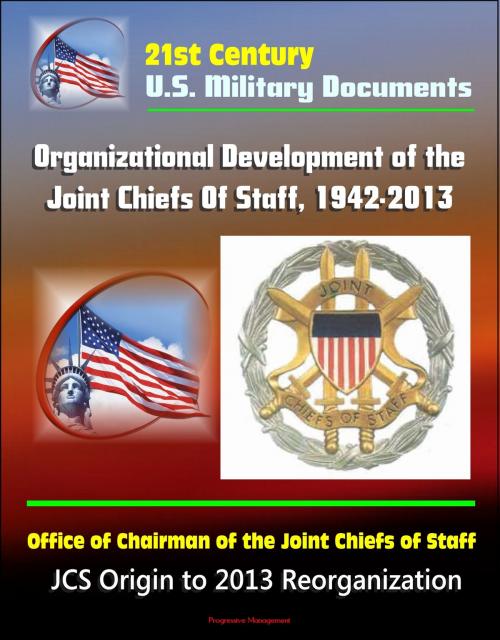21st Century U.S. Military Documents: Organizational Development of the Joint Chiefs Of Staff, 1942-2013, Office of Chairman of the Joint Chiefs of Staff - JCS Origin to 2013 Reorganization
Nonfiction, History, Military, United States| Author: | Progressive Management | ISBN: | 9781310390623 |
| Publisher: | Progressive Management | Publication: | November 13, 2013 |
| Imprint: | Smashwords Edition | Language: | English |
| Author: | Progressive Management |
| ISBN: | 9781310390623 |
| Publisher: | Progressive Management |
| Publication: | November 13, 2013 |
| Imprint: | Smashwords Edition |
| Language: | English |
This book examines the organizational origins and evolution of the Joint Chiefs of Staff and the Joint Staff over the past seventy-one years. Established in January 1942 to expedite strategic coordination during World War II, the Joint Chiefs of Staff have been at the center of US military planning ever since. Composed of the nation's senior military officers, the Joint Chiefs of Staff initially operated under the direct authority and supervision of the President, performing whatever duties he assigned in his capacity as Commander in Chief.
After World War II, as part of the 1947 reorganization of the armed services under the National Security Act, the Joint Chiefs of Staff acquired statutory standing, with a list of assigned duties, and became a corporate advisory body to the President, the Secretary of Defense, and the National Security Council. Subsequent amendments to the National Security Act refined the composition and statutory organization of the Joint Chiefs and further clarified their authority and responsibilities. The corporate nature of the Joint Chiefs' advisory role ended upon passage of the 1986 Goldwater-Nichols Act, which transferred the tasks and duties previously performed collectively by the JCS to the Chairman.
The Joint Staff has continued to evolve since the terrorist attacks on September 11, 2011. This volume incorporates the changes to the organization of the Joint Staff which resulted from the August 2011 disestablishment of Joint Forces Command.
- Origin of the Joint Chiefs of Staff * Establishing the Joint Chiefs of Staff * The Wartime Reforms * 2. The National Security Act of 1947 * Postwar Plans for Defense Organization * Passage of the National Security Act * Organizing the Joint Staff * The Key West Agreement of 1948 * 3. The National Security Act Amendments of 1949 * 4. Reorganization Plan No. 6 of 1953 * 5. The Defense Reorganization Act of 1958 * The President's Plan * Implementing the President's Plan * 6. Developments in the 1960s and 1970s * Changes through 1967 * Organizational Consolidation, 1968-1976 * Changes in the Carter Period * 7. The Reorganization of 1986 * The Jones and Meyer Proposals * Changes, 1982-1984 * The Goldwater-Nichols Defense Reorganization Act * 8. Joint Staff Reorganization, 1989 - 2001 * After Goldwater-Nichols * Peacekeeping & Humanitarian Assistance * Proposals for Major Headquarters Reductions * 9. Joint Staff Reorganization, 2001- 2013 * The Joint Staff After the 9-11 Attacks * Chief of the Guard Bureau Elevated to the JCS * The Disestablishment of Joint Forces Command * Appendix 1 - Membership of the Joint Chiefs of Staff * Appendix 2 - Authorized and Assigned Strength of the Organization of the Joint Chiefs of Staff and The Joint Staff (1947 - 2012)
This book examines the organizational origins and evolution of the Joint Chiefs of Staff and the Joint Staff over the past seventy-one years. Established in January 1942 to expedite strategic coordination during World War II, the Joint Chiefs of Staff have been at the center of US military planning ever since. Composed of the nation's senior military officers, the Joint Chiefs of Staff initially operated under the direct authority and supervision of the President, performing whatever duties he assigned in his capacity as Commander in Chief.
After World War II, as part of the 1947 reorganization of the armed services under the National Security Act, the Joint Chiefs of Staff acquired statutory standing, with a list of assigned duties, and became a corporate advisory body to the President, the Secretary of Defense, and the National Security Council. Subsequent amendments to the National Security Act refined the composition and statutory organization of the Joint Chiefs and further clarified their authority and responsibilities. The corporate nature of the Joint Chiefs' advisory role ended upon passage of the 1986 Goldwater-Nichols Act, which transferred the tasks and duties previously performed collectively by the JCS to the Chairman.
The Joint Staff has continued to evolve since the terrorist attacks on September 11, 2011. This volume incorporates the changes to the organization of the Joint Staff which resulted from the August 2011 disestablishment of Joint Forces Command.
- Origin of the Joint Chiefs of Staff * Establishing the Joint Chiefs of Staff * The Wartime Reforms * 2. The National Security Act of 1947 * Postwar Plans for Defense Organization * Passage of the National Security Act * Organizing the Joint Staff * The Key West Agreement of 1948 * 3. The National Security Act Amendments of 1949 * 4. Reorganization Plan No. 6 of 1953 * 5. The Defense Reorganization Act of 1958 * The President's Plan * Implementing the President's Plan * 6. Developments in the 1960s and 1970s * Changes through 1967 * Organizational Consolidation, 1968-1976 * Changes in the Carter Period * 7. The Reorganization of 1986 * The Jones and Meyer Proposals * Changes, 1982-1984 * The Goldwater-Nichols Defense Reorganization Act * 8. Joint Staff Reorganization, 1989 - 2001 * After Goldwater-Nichols * Peacekeeping & Humanitarian Assistance * Proposals for Major Headquarters Reductions * 9. Joint Staff Reorganization, 2001- 2013 * The Joint Staff After the 9-11 Attacks * Chief of the Guard Bureau Elevated to the JCS * The Disestablishment of Joint Forces Command * Appendix 1 - Membership of the Joint Chiefs of Staff * Appendix 2 - Authorized and Assigned Strength of the Organization of the Joint Chiefs of Staff and The Joint Staff (1947 - 2012)















